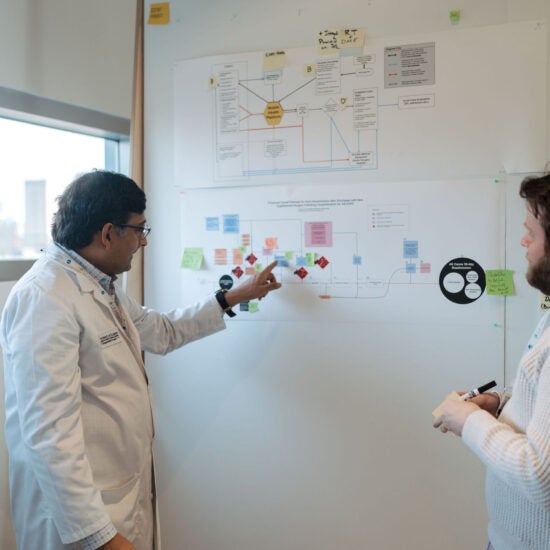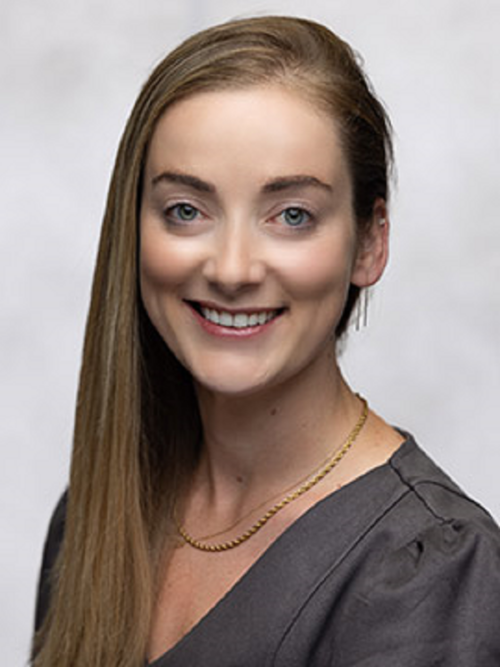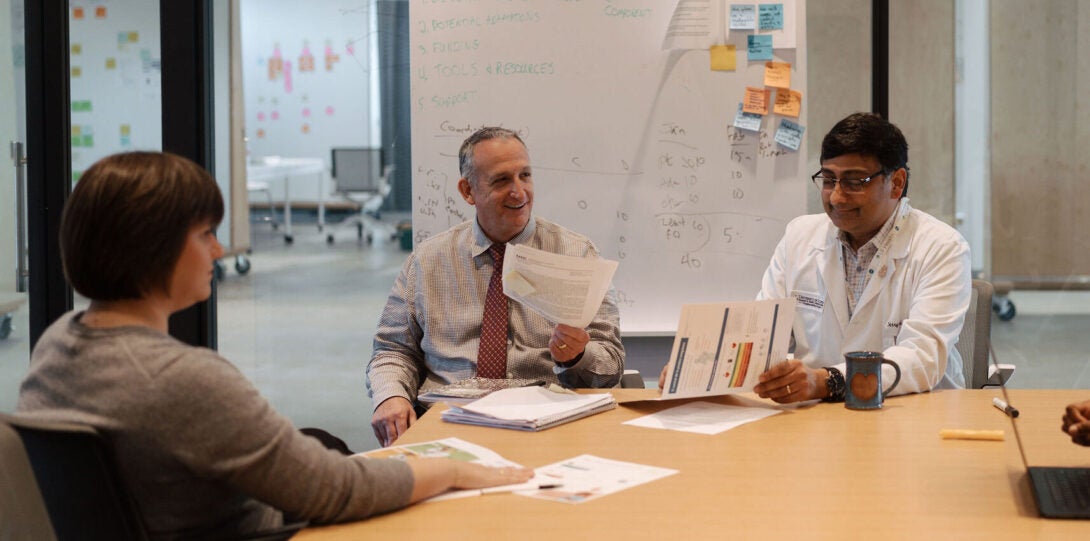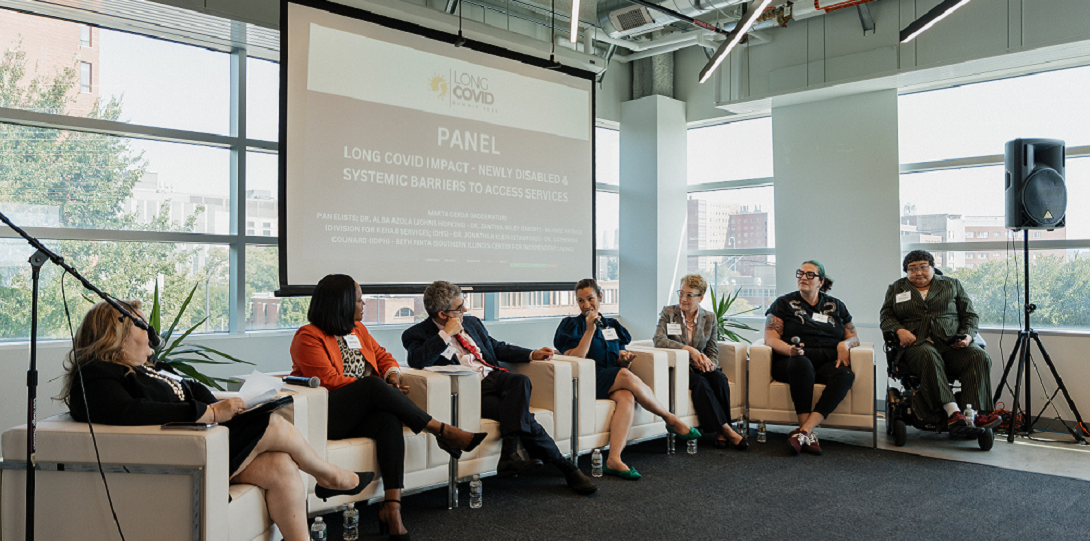Annual Report
Office of Population Health Sciences | 2024 - 2025
Introduction

Access to healthcare and resources like healthy food, education, and employment plays a decisive role in the health and wellbeing of communities. UI Health’s Office of Population Health Sciences (OPHS) focuses on developing, testing, and implementing population-specific programs that meet these needs in support of health equity.
The onset of the COVID-19 pandemic in early 2020 exacerbated long-standing health disparities, resulting in unacceptably high rates of mortality and morbidity and underscoring the urgency of OPHS’ work for communities in need. While many institutions focus on “raising the ceiling” in healthcare through the development of new medications and technologies, OPHS is dedicated to raising healthcare’s floor and ensuring that disadvantaged communities receive timely, equitable and high-quality services. Its work is informed by direct input from affected populations, including the triennial community health needs assessments.
In this report, we share stories, profiles, and data that illustrate OPHS’ vital work toward greater health equity. One story told here explains how research, education, and collaboration led to legislation ensuring that children across Illinois have access to lifesaving medications in their schools. Another details how research into the biological mechanisms at play in Long COVID could lead to new treatments for everyone in need, including those disproportionately impacted by the condition.
The report also includes a story about OPHS’s Institute for Healthcare Delivery Design (IHDD) and its role in the launch of Illinois’ Healthcare Transformation Collaboratives, which has contributed $1 billion toward transforming healthcare delivery in vulnerable communities. We hope that the stories and profiles in this report inspire you to join the Office of Population Health in working to make health equity a reality.
Jerry Krishnan, MD, PhD
Associate Vice Chancellor, Office of Population Health Sciences
University of Illinois Chicago
OPHS At A Glance

Three sources of funds support OPHS: External Research, External Advising, and Institutional Support.
External Research sources of revenue include awards from the National Institutes of Health, the Patient Centered Outcomes Research Institute and other funders.
External Advising revenues are generated through contracts with state agencies and other entities for IHDD’s professional advisory services.
OPHS enjoys Institutional Support through the Office of the Vice Chancellor for Health Affairs. In 2022, the Chancellor’s Office provided $250,000 to have OPHS launch and administer a limited-competition program aimed at supporting the design and conduct of pilot studies in Long COVID to enhance UIC’s capacity to successfully compete for NIH funding opportunities across the spectrum of translational science. Among the pilot study funding recipients, Dr. Bellur Prabakar in the College of Medicine went on to receive $1.2 million in funding from the National Heart, Lung, and Blood Institute, and Dr. Sanjib Basu in the School of Public Health was awarded $1.05 million from the National Institutes of Health. Together these two awards generated almost ten times the amount of the entire seed funding program. A third participant in the program is expected to receive funding from NIH soon.
Together the three streams of revenue have enabled OPHS to grow between FY21 and FY23. A reduction in research funding in FY24 was partially offset by continued growth in IHDD’s advising services business. This diversified portfolio approach to OPHS’s activities helps even out ebbs and flows of any individual revenue stream.
The growth of OPHS activities has been supported by the nearly doubling of full-time employees over a 4 year period.
OPHS also works with a large number of individual contractors who bring specific expertise to projects and added capacity for large undertakings. The hybrid model of full-time employees supplemented with contractors enables OPHS to grow to the needs of specific projects and thereafter shrink to a sustainable size.

While many institutions focus on “raising the ceiling” in healthcare through the development of new medications and technologies, the Office of Population Health Sciences is dedicated to raising healthcare’s floor and ensuring that disadvantaged communities receive timely, equitable and high-quality services.
Institute for Healthcare Delivery Design

“Meeting People Where They Are”
Underserved communities face multiple barriers to accessing quality healthcare and services for related needs. Because they operate at scale, many healthcare systems can be difficult to navigate and confusing for intended beneficiaries. This is why usability and accessibility are at the heart of the work done by UIC’s Institute for Healthcare Delivery Design. “We use human-centered design to understand the operational and experiential dimensions of health services.” says Hugh Musick, Assistant Vice Chancellor of Population Health Sciences and Director of the Institute for Healthcare Delivery Design. The goal of this diagnostic approach is to identify points of friction and areas of opportunity to make service systems more accessible, effective, and useful for people. “If we do this well, it can contribute to reducing health disparities,” Musick says.
One example is IHDD’s work with the Illinois Department of Healthcare and Family Services to conceptualize and launch Health Care Transformation Collaboratives, an initiative to fund health system and community partnerships so they can pilot new models for meeting the health needs of Medicaid customers. A 2021 state law made $1 billion in funding available from 2021 through 2026 for these collaboratives, which has since led to the creation of more than a dozen collaboratives across Illinois, including UI Health’s specialty care clinic in Chicago’s Gage Park neighborhood.

“We view all of our work through clinical, operational, community, and health system lenses.”
| Co-Director, IHDD
Research Projects
Breathe Easier: Stock Albuterol Inhalers for Schools

More than one in ten children in the US have asthma. Each year, childhood asthma exacerbations will lead to 750,000 emergency department visits, 200,000 hospitalizations, and about 200 deaths.
A life-saving form of medication known as short acting bronchodilators can be delivered to the lungs through a handheld inhaler. Inexpensive and safe, inhalers can be used by almost anyone who experiences respiratory symptoms. However, 80% of children with asthma, rich or poor, urban or rural, do not have access to this medication in schools.
OPHS Assistant Vice Chancellor, Lynn Gerald, PhD, MSPH, works with schools to help children with asthma live healthier lives. In 2013, her team conducted a pilot study where inhalers were stocked in schools. 911 calls for respiratory distress fell 20% and EMS transports dropped 40% in schools where the program was implemented. “This simple intervention is having the greatest impact on asthma in children that I have seen in my 30 year career,” says Gerald.
In 2017, Gerald led the passage of stock inhaler legislation in Arizona. Since then, she’s helped other states do the same. In 2018, the MidStates Chapter of the Allergy and Asthma Foundation (AAFA) and the Respiratory Health Association (RHA) led a push for stock inhaler programs in Illinois. This effort resulted in a $2.4 million appropriation to create the RESCUE program which provides medication, equipment, and an implementation handbook to more than 3,100 (80%) public schools across the state. “The initiative will help students with asthma stay safe and focus on their studies”, Gerald says, “and keeping children in class so they can improve their education is key to improving health equity.”
RECOVER Study: Focus on Long COVID

Long COVID is an infection-associated chronic condition that occurs after SARS-CoV-2 infection and is present for at least 3 months as a continuous, relapsing and remitting, or progressive disease state that affects one or more organ systems. Symptoms vary widely and can persist anywhere from days to months after the initial onset of the disease. Despite the range of potential symptoms, one thing is clear: Long COVID is a real and growing cause of long-term disability.
Researching COVID to Enhance Recovery (RECOVER) is a nationwide initiative from the National Institutes of Health to understand, diagnose, prevent, and treat Long COVID. As Principal Investigator for the Illinois Research Network (ILLInet) Hub, Jerry Krishnan, MD, PhD leads a consortium of community and faith-based organizations, health systems, and investigators in Chicago and Peoria. “We are listening closely to what people in vulnerable communities are telling us about how they are affected by COVID,” he says.
OPHS and community organizations have collaborated through the ILLInet Hub to disseminate new findings and educate healthcare providers across Illinois on how to support and treat Long COVID patients. This information helped inform the creation of UI Health’s Long COVID clinic.
Leaders of our partner organizations have served on national advisory committees and advocated for change at population
levels. In 2023, Dr. Krishnan was asked to testify before members of the Illinois General Assembly about Long COVID as a source of long-term disability. In September 2024, OPHS, together with community partners, hosted the 2024 National Long COVID Summit to provide an update on the current research and strategies for raising public awareness and treating individuals with Long COVID. “The work we are doing in Long COVID is helping to unlock mysteries about how people recover from an infection due to SARS-CoV-2. We hope to apply the lessons learned to help individuals recover more quickly from other infectious illnesses,” Krishnan says.
Health Equity and Access: Eye Care

Reducing preventable blindness in vulnerable populations is the goal of Angel Scanzera, OD, Director of the Tele-Ophthalmology Service and Contact Lens Fellowship program in UI Health’s Department of Ophthalmology.
In 2021, Dr. Scanzera began work on an application for a National Institutes of Health K23 Career Development Award which would help her study barriers to eye care visits in diverse urban populations and develop interventions to close gaps.
She was encouraged by Ophthalmology Department Chair Dr. Paul Chan to connect with OPHS and IHDD and to seek their input and guidance on her proposed study. Mentorship from Dr. Jerry Krishnan and Hugh Musick led Dr. Scanzera to integrate a human-centered design approach into her application.
In late 2023, Dr. Scanzera was awarded a K23 Award, and in 2024, she worked with design researchers from IHDD to interview community residents and better understand the barriers they faced when seeking eye care.
In 2025, Dr. Scanzera and the IHDD team will turn their attention to implementing a transportation intervention and measuring its impact on adherence to ophthalmology visits. “We are finding eye care solutions for vulnerable communities—and making sure we listen closely to people who live in these communities,” she says. “This is about helping healthcare fit what people need.”
OPHS Milestones
| Year | Milestone |
|---|---|
| 2011 | Population Health Sciences Program established within the Office of the Vice President for Health Affairs (subsequently renamed Office of the Vice Chancellor for Health Affairs |
| 2012 | Integration of Englewood Health Center into Mile Square FQHC |
| 2013 | Interdisciplinary UI Health Innovation Strategy Awards. Complete first UI Health Community Assessment of Needs (UI-CAN) |
| 2014 | CHICAGO Plan PCORI contract to test multilevel interventions in five healthcare organizations to improve health of children with uncontrolled asthma |
| 2015 | Student research awards to fund cross-college research featuring interprofessional models of care |
| 2016 | Second triennial UI-CAN |
| 2017 | Program for Healthcare Delivery Design established, introducing human centered design in healthcare delivery and research. |
| 2017 | UI Health PROgram for Non-emergency TranspOrtation (PRONTO) to overcome transportation related barriers to accessing healthcare |
| 2018 | Student experience blueprint for the College of Medicine |
| 2019 | Third triennial UI-CAN |
| 2019 | Strategy to reconceive the Center for Outcomes Research at the COM Peoria |
| 2020 | Collaborate with Verily Life Sciences in the PRESCO study |
| 2021 | HHS National Institutes of Health awards to design and implement a national research communications center to support ACTIV 4B and 4C clinical trials of thromboprophylaxis for COVID-19 |
| 2022 | Oversee the development of the Illinois Department of Human Services Health Outcomes Disparity Report |
| 2023 | RESCUE Illinois Schools (stock inhaler program) provided medication, equipment, and an implementation handbook to more than 3,100 schools, or approximately 80% of Illinois public schools |
| 2024 | National Academies of Sciences, Engineering, and Medicine report defining Long COVID as an infection associated chronic condition |
OPHS Profiles

Denise Kent is a third-generation nurse who has worked in intensive care and as a family nurse practitioner. Now, she’s an Assistant Professor at the UIC College of Nursing, and has funding for a pilot study through the National Institutes of Health-funded RECOVER project. Her project is exploring the preferences and experiences of patients who participated in the RECOVER Long COVID study. Kent’s research draws upon participants’ individual research results (IRRs): the data collected, generated, or discovered during a research study that is specific to an individual.
“Studying the experiences and preferences of RECOVER participants—a large portion of whom are from underrepresented groups—gives us an opportunity to develop a process for sharing information about Long COVID in a meaningful way,” Kent says. But this research has another major benefit: “If we treat people right in research, they are more likely to want to be part of a research project again,” she adds. “That benefits communities—and our research.”
| UIC College of Nursing

There is a level of expertise in the community that is different from what academics have. And you have to honor the community voice. The language is more plain, more straightforward. The community speaks in practical terms and understands the cultural nuances.
| Bright Star Community Outreach, Chicago

Peter Xu is pursuing a degree in respiratory therapy at Malcolm X College in Chicago, and has previously worked as a mentor and case manager for community-based health programs. This year, he has been developing his skills as an intern in a clinical research setting with OPHS. “I wanted to have a better understanding of how to care for people on a medical level,” he says. “In respiratory health, you have to understand how things work on a cellular level. This internship is a great way to learn more of what I need to know.”
One aspect of his internship involves preparing materials to train clinical research staff on the anatomy and physiology of the respiratory system. He has also shadowed pulmonologists, respiratory therapists and other staff, which has helped connect clinical care to his research. “There have been a lot of shadowing opportunities in this internship,” Xu says. “It’s been so helpful to understand how pulmonologists and other staff support patients—and how respiratory therapists are an important part of this process.”
| Breathe Chicago Center Intern

Respiratory Health Association (RHA), a Chicago-based not-for-profit organization dedicated to promoting lung health and fighting lung disease, including the nation’s asthma epidemic. In 2022, the RHA released a report that showed “Black children [in Chicago] are more than four times as likely to end up in a hospital emergency room due to asthma than white children.” The following year, RHA convened the Illinois Stock Albuterol in Schools Advisory Committee to get stock inhalers into schools across Illinois along with the infrastructure, logistics, training, and management needed to maintain that system. Erica Salem says that this program is addressing major disparities, both for children with
asthma and those vulnerable to developing the condition. “I know we’re saving lives and showing how providing these inhalers makes a big difference in our communities.”| Senior Director (Strategy, Programs & Policy)


